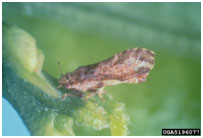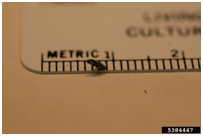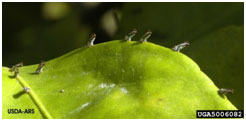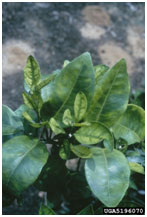Diaphorina citri.

What to look for
Tiny dark psyllid insects resting at 45⁰ angle whilst feeding on young leaves.
What you can do
- Do not move plants, plant material or fruit (especially citrus fruit) out of the Torres Strait Protected Zone to the Torres Strait Permanent Biosecurity Monitoring Zone, or from either zone to mainland Australia without a permit and an inspection by a departmental biosecurity officer.
- Report any signs of poor health of citrus plants to the department by phone on +61 7 4241 7800 or email NAQS.

Profile
The Asian citrus psyllid is a small, sap-sucking insect. The psyllid is a serious pest of young citrus trees and can also transmit the citrus disease Huanglongbing (HLB, formerly known as citrus greening) that makes fruit taste bitter and will eventually kill the tree (see Huanglongbing).

The vector of deadly Huanglongbing disease
Identification
The adults are 3-4 mm long with brown markings on the wings. They feed mostly on the veins of the young leaves and adopt a ‘head-down, tail-up’ position when feeding. Juvenile psyllids are yellow and commonly found feeding on young, soft shoots. This pest is also found on the citrus relatives mock-orange and curry leaf.
Distribution
Widespread in Asia and also present in New Guinea, where HLB is also present and is killing citrus trees. This pest recently invaded South, Central and North America.

Psyllids are 3-4 mm long
Threat
The psyllid is a weak flyer and is most likely to be spread over larger distances as eggs or nymphs transported on host plants. Introduction of this pest and the disease it spreads would destroy home-grown citrus trees and devastate the citrus industry.
Keep a Top Watch!
Contact your local departmental office if you see any unusual, small insects on citrus trees or a decline in the health of your citrus trees.

Adult psyllids feeding on a leaf

Leaf damage caused by psyllids
